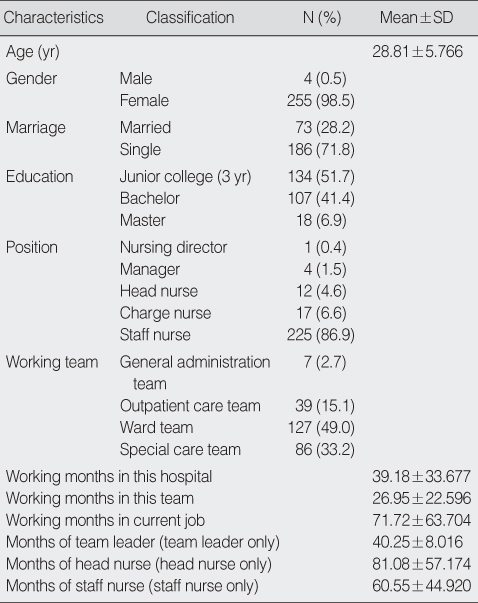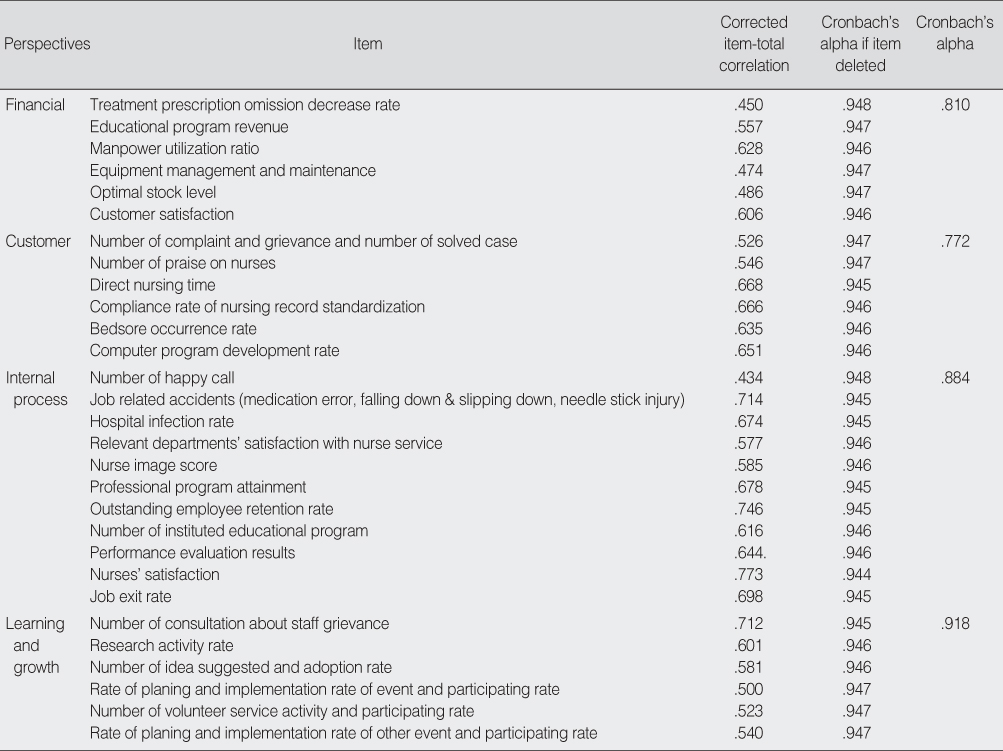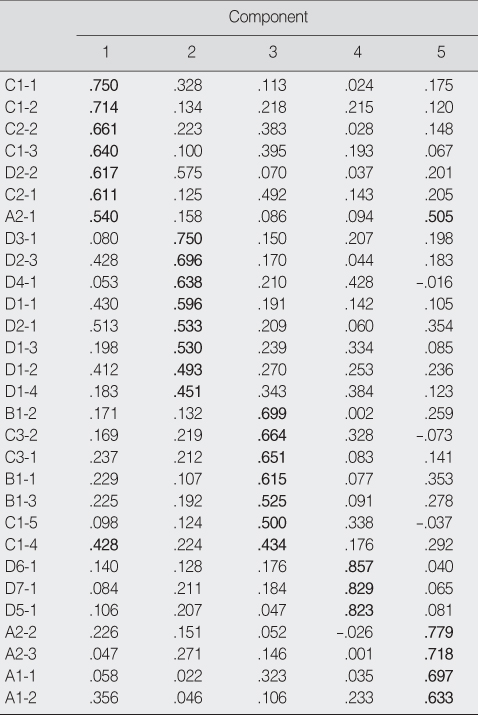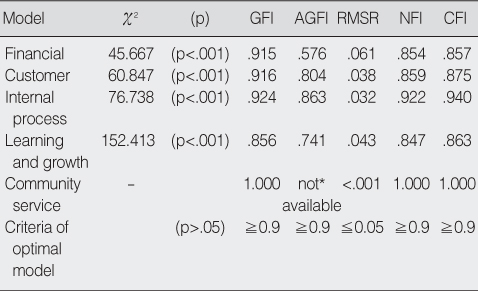Articles
- Page Path
- HOME > J Korean Acad Nurs > Volume 38(1); 2008 > Article
-
Original Article
- Balanced Scorecard for Performance Measurement of a Nursing Organization in a Korean Hospital
- Yoonmi Hong, Kyung Ja Hwang, Mi Ja Kim, Chang Gi Park
-
Journal of Korean Academy of Nursing 2008;38(1):45-54.
DOI: https://doi.org/10.4040/jkan.2008.38.1.45
Published online: February 29, 2008
1Associate Professor, Department of Nursing, Kwandong Universty, Gangneung, Korea.
2Director of Nursing Department, Myongji Hospital, Kwandong Universty, Goyang, Korea.
3Professor and Dean Emeritus, College of Nursing, Universty of Illinois at Chicago, Chicago, USA.
4Senior Health Economist, College of Nursing, Universty of Illinois at Chicago, Chicago, USA.
- Address reprint requests to: Hong, Yoonmi. Department of Nursing, College of Medicine, Kwandong University, 522 Naegok-dong, Gangneung 210-701, Korea. Tel: 82-33-649-7619, Fax: 82-33-649-7620, ymhong@kwandong.ac.kr
Copyright © 2008 Korean Society of Nursing Science
Abstract
-
Purpose
- The purpose of this study was to develop a balanced scorecard (BSC) for performance measurement of a Korean hospital nursing organization and to evaluate the validity and reliability of performance measurement indicators.
-
Methods
- Two hundred fifty-nine nurses in a Korean hospital participated in a survey questionnaire that included 29-item performance evaluation indicators developed by investigators of this study based on the Kaplan and Norton's BSC (1992). Cronbach's alpha was used to test the reliability of the BSC. Exploratory and confirmatory factor analysis with a structure equation model (SEM) was applied to assess the construct validity of the BSC.
-
Results
- Cronbach's alpha of 29 items was .948. Factor analysis of the BSC showed 5 principal components (eigen value >1.0) which explained 62.7% of the total variance, and it included a new one, community service. The SEM analysis results showed that 5 components were significant for the hospital BSC tool.
-
Conclusion
- High degree of reliability and validity of this BSC suggests that it may be used for performance measurements of a Korean hospital nursing organization. Future studies may consider including a balanced number of nurse managers and staff nurses in the study. Further data analysis on the relationships among factors is recommended.
- 1. Chow CW, Ganulin D, Teknika O, Haddad K, Williamson J. The balanced scorecard: a potent tool for energizing and focusing healthcare organization management. J Healthc Manag. 1998;43:263–280.ArticlePubMed
- 2. Cronin SN, Becherer D. Recognition of staff nurse job performance and achievements: staff and manager perceptions. J Nurs Adm. 1999;29(1):26–31.
- 3. Curtright JW, Stolp-Smith SC, Edell ES. Strategic performance management: development of a performance measurement system at the Mayo Clinic. J Health Manag. 2000;45(1):58–68.Article
- 4. Ha CH. Balanced performance measurement system for strategic learning. 2001;Seoul, Sogang University. Unpublished master's thesis.
- 5. Hair JF, Tatham RL, Anderson RE, Black W. Multivariate data analysis. 1998;5th ed. New Jersey, Prentice Hall Inc..
- 6. Jang HW, Lee SS. A study on the effects of critical success factors to the management performance. DAEHAN J Business. 2006;19:2561–2584.
- 7. Kang KH, Kim IS. Development of performance measure indicators in hospital nursing units. J Korean Acad Nurs. 2005;35:451–460.ArticlePDF
- 8. Kaplan RS, Norton DP. The balanced scorecard-measures that drive performance. Harv Bus Rev. 1992;70(1):71–79.PubMed
- 9. Kim HJ. A study on indicator development to evaluate hospital information system-based on balanced scorecard method. 2006;Seoul, Yonsei University. Unpublished master's thesis.
- 10. Kim IS, Lee HJ, Kang KH, Jang SJ. A survey for performance measurement indicators of nursing organizations in hospitals. J Korean Acad Nurs Admin. 2005;11:385–399.
- 11. Kim JH. The reliability and validity test of psychosocial well-being index (PWI). J Korean Acad Nurs. 1999;29:304–313.ArticlePDF
- 12. Kim WP. Lectures on statistical analysis by SPSS-basic course. 2005;Seoul, Research Institute for Society and Statistics.
- 13. Kim YK, Lee SB. A study on the performance measurement of PBLIS using BSC. J Korean Society Cadastre. 2005;21:17–32.
- 14. Kim YS. Development of performance measurement indicators for nursing on delivery units. 2006;Seoul, Yonsei University. Unpublished master's thesis.
- 15. Kwak T, Chang H, Song J. Development of performance indicators based on balanced scorecard for school food service facilities. Korean J Community Nutrition. 2005;10:905–919.
- 16. Lee YU. Using the balanced scorecard in a department of police investigation. 2005;Seoul, Hankuk University of Foreign Studies. Unpublished master's thesis.
- 17. Lee YY, Lim NY, Park HA. Nursing and medical research, and statistics. 1998;Seoul, Somoon Publishing Company.
- 18. Nam MS, Park JS, Rhu RD. The system of performance evaluation for the realization of knowledge management, team play and annual salary system. 1999;Seoul, Korea Publication Society for the Press Data.
- 19. Niven PR. Balanced scorecard-step by step: maximizing performance and maintaining results. 2002;New York, John Wiley & Sons, Inc..
- 20. Park GS, Bae BH. A study on the interactions of between team task-characteristics and diversity performance measures, team-based compensation on the team performance. J Bus Res. 2004;19:115–142.
- 21. Park SH. Development of criteria of performance evaluation for hematopoietic stem cell transplantation nursing unit. 2004;Seoul, Seoul National University. Unpublished maste's thesis.
- 22. Shin SS, Huh DW. A study on the measuring CRM system performance using Balanced Scorecard. Korean J Accounting Research. 2005;10(1):25–50.
- 23. Streiner LD, Norman RG. Health measurement scales a practical guide to their development and use. 2003;3rd ed. New York, Oxford University Press Inc..
- 24. Sung TJ. The validity and reliability test. 1995;Seoul, Yangsewon.
- 25. Waltz CF, Bausell RB. Nursing research design statistics and computer analysis. 1981;Philadelphia, F. A. Davis company.
- 26. Yi SW, Jung YD. A Study on the Non-financial Drivers Influencing the Performance of Small and Medium Firms in Automobile Parts Industry. In: Paper presented at the meeting of the DAEHAN Association of Business Administration. 2006;Seoul, Korea.
- 27. Yoo JI. Development of a Performance measurement system for the perioperative nursing unit using the balanced scorecard. 2001;Seoul, Yonsei University. Unpublished master's thesis.
REFERENCES
Figure & Data
REFERENCES
Citations

- The rating model of corporate information for economic security activities
Onechul Na, Lee Won Park, Harang Yu, Yanghoon Kim, Hangbae Chang
Security Journal.2019; 32(4): 435. CrossRef - Development of Performance Indicators for Clinical Research Coordinators Using the Balanced Scorecard in South Korea
Youn Sun Hwang, Tae Wha Lee
Therapeutic Innovation & Regulatory Science.2019; : 216847901987075. CrossRef - Development and Application of a Performance Prediction Model for Home Care Nursing Based on a Balanced Scorecard using the Bayesian Belief Network
Wonjung Noh, GyeongAe Seomun
Journal of Korean Academy of Nursing.2015; 45(3): 429. CrossRef - Development of Nursing Key Performance Indicators for an Intensive Care Unit by using a Balanced Scorecard
Yun Jeong Choi, Ji Young Lim, Young Whee Lee, Hwa Soon Kim
Journal of Korean Academy of Nursing.2008; 38(5): 656. CrossRef
General Characteristics (N=259)
Reliability Test Results
Rotated Component Matrix
Extraction method: Principal component analysis.
Rotation method: Varimax with kaiser normalization.
A rotation converged in 8 iterations.
Comparison of Original and Revised BSC
BSC=balanced scorecard.
Model Fitness Test Results
Ho: the model fits the data perfectly.
*not available means the saturated state.
Extraction method: Principal component analysis. Rotation method: Varimax with kaiser normalization. A rotation converged in 8 iterations.
BSC=balanced scorecard.
Ho: the model fits the data perfectly. *not available means the saturated state.
 KSNS
KSNS
 E-SUBMISSION
E-SUBMISSION





 Cite
Cite

